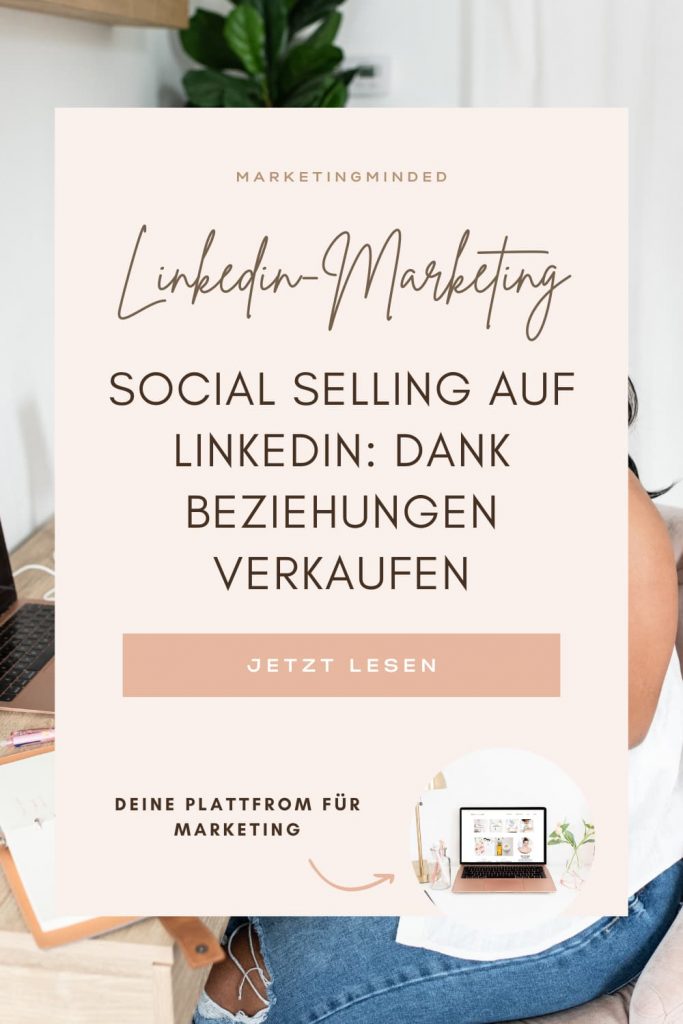
If you’re involved in marketing on LinkedIn, you can’t avoid social selling. And that’s no surprise—LinkedIn, thanks to its “trade fair character,” is particularly well-suited for a social selling strategy.
What is Social Selling?
Social selling means actively building relationships with your dream customers, thereby strengthening their trust in and fondness for you—with the goal of selling your products.
In contrast to traditional sales, social selling focuses on building real and authentic relationships with prospects and potential clients. The sales aspect is not at the forefront. Your target audience shouldn’t get the feeling that you’re only being nice to them because you want them to buy from you. It’s about building long-term, trust-based relationships.
Selling your products and services is, in a way, a byproduct of good social selling.
You sell on LinkedIn through your expert status and the trust people have in you. The point is for your target audience to clearly recognize that you are the go-to person for your topic and know exactly what they can expect from you. Your goal is to already be present in their minds for your subject matter before they even realize they have a need. That way, when the need arises, they come directly to you—without researching other options. They know: if they need X, then only from you.
To practice successful social selling, it’s essential that you consistently show what you’re capable of—as well as what you offer—in a way that provides value to your audience.
Social selling thrives on a strong personal brand and strategic content.
The Basics of Social Selling on LinkedIn
To practice social selling successfully on LinkedIn, you first need to understand how the LinkedIn algorithm works. The LinkedIn algorithm shows users the content it deems most relevant to them and that has the highest likelihood of generating engagement.
This means: your posts are pre-sorted by the algorithm to reach the people most likely to be interested. This happens in several stages. The more relevant your post is to your network, the longer it stays visible in the newsfeed. And that in turn means more visibility for you.
Building Expert Status
To create relevant content, you need a clear picture of your target audience. What needs does your dream customer have? What problems? How exactly can you help? The clearer the image you have—of your potential customers, but also of yourself, your products, and services—the more precisely you can create tailored content.
Building expert status takes time, patience, and consistency. Genuine interactions and relationships are critical for social selling. People love to buy from people where it feels human. Show your approachable side, communicate at eye level, and make it clear that you truly know what you’re talking about.
LinkedIn is the Perfect Platform for Social Selling
And for one very simple reason: everything works together naturally here.
You don’t have to work extra hard to sell something. It’s enough to offer value and show who you are and what you do. After all, people are on the platform exactly for that reason—they want to stay up to date on industry trends, connect with others, and discover new insights.
With a well-maintained profile and regular posts, you almost automatically build a personal brand and an expert reputation—and in doing so, you’re already practicing social selling on the side.
Sounds simple, right? It is.
Tips for Successful Social Selling
To make getting started even easier, here are five tips to help you succeed with social selling:
1. Optimize Your LinkedIn Profile
Your LinkedIn profile should give strangers a quick and clear sense of who you are and what you do. It should be professional and fully filled out.
Make sure your profile picture, headline, and “About” section are strong and communicate clearly.
2. Share Content That’s Valuable for Your Target Audience
The content you share should be informative and useful to your audience.
This can include: industry news, customer feedback, your opinion on certain tools, your learnings, or changes you’ve observed. Don’t forget to mention from time to time what exactly you offer—so that your dream customers know what they can come to you for.
3. Interaction is a Key Factor
And by that, I don’t mean just the engagement on your own posts (although that’s also important).
Be active on LinkedIn and interact with the posts of your contacts—and their contacts. Build relationships with people who are part of your target audience.
4. Grow Your Network Strategically
This means: don’t send out random connection requests.
The car dealer next door will never buy from you—no matter how great your relationship is—if you sell pink plastic palm trees.
Connect with people in your industry and actively search for people who belong to your target audience.
(You’ll find more on how to strategically build your LinkedIn network in this guide.)
5. Trust. Trust. Trust.
Be authentic and show what makes you you.
Social selling is deeply rooted in likeability and trust. People buy from people—especially from those they like and can trust. Build trust by communicating openly and honestly, speaking to your audience at eye level, and consistently providing real value.
The Social Selling Index: Measuring the Success of Social Selling
Another reason LinkedIn is great for social selling: you can measure your success.
LinkedIn provides you with a tool called the Social Selling Index (SSI) that shows how well your profile is optimized for social selling. The index calculates a score based on your personal brand, your network, your content, and the relationships you maintain with your contacts.
A high score indicates that your profile and content are already doing a good job of “selling”—without you having to actively sell. A score between 60 and 80 is already good. Anything above that is fantastic.
You can use this data to actively refine your strategy and become even more successful on LinkedIn.
Trust is the Key to Success on LinkedIn
To sum up, social selling isn’t primarily about selling products—
it’s about positioning yourself as an expert and making valuable connections.
Thanks to the close relationships you build with (potential) customers, you almost automatically make sales
and position yourself and your expertise in their minds before they even realize they need your help.





